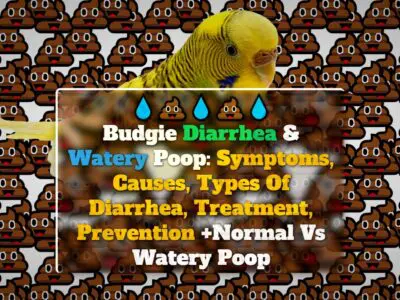Budgie poop, or droppings, vary in color, texture, and consistency based on the bird’s diet, hydration, and health.
Normal budgie droppings are small, round, and consist of a dark, solid part (feces) and a white part (urates).
Abnormalities such as watery, white, yellow, green, dark green, black, brown, red, or orange droppings could indicate health issues like infections or digestive problems.
Let’s chat, dear reader, about budgies.
No, not just about their vivid hues or joyful songs, but about something you might not often consider — their droppings.
Now, you might be thinking, “Why would I want to discuss budgie poop?” Well, as a bird enthusiast and a former veterinary worker, I can assure you that observing your budgie’s droppings can offer a wealth of knowledge about their health.
You know, back when I owned a budgie, observing their poop became a part of my daily routine.
I could tell so much about their health from their droppings.
Also, they were everywhere!
Budgie Poop Types, Colors, Textures
Understanding your budgie’s droppings goes beyond a quick glance.
There is an art to reading them, an art that starts with knowing the different types, colors, and textures.
You see, budgie droppings can vary drastically depending on the bird’s diet, hydration levels, and overall health.
By becoming attuned to these variations, you can ensure that you’re keeping a close eye on your feathered friend’s well-being.
From the lighter-colored droppings indicative of a seed-based diet to the darker ones typical of a diet rich in fruits and vegetables, the color of your budgie’s poop can reveal a lot about their nutritional intake.
Similarly, the texture can help you decipher whether your budgie is properly hydrated.
For instance, overly dry droppings may signal dehydration, while extremely wet droppings could hint at possible diarrhea.
Normal Budgie Poop (What Color And Texture Should Budgie Poop Look Like?)
So, what does normal budgie poop look like, you might ask? Well, in general, a healthy budgie’s droppings consist of three parts: the feces, the urine, and the urates.
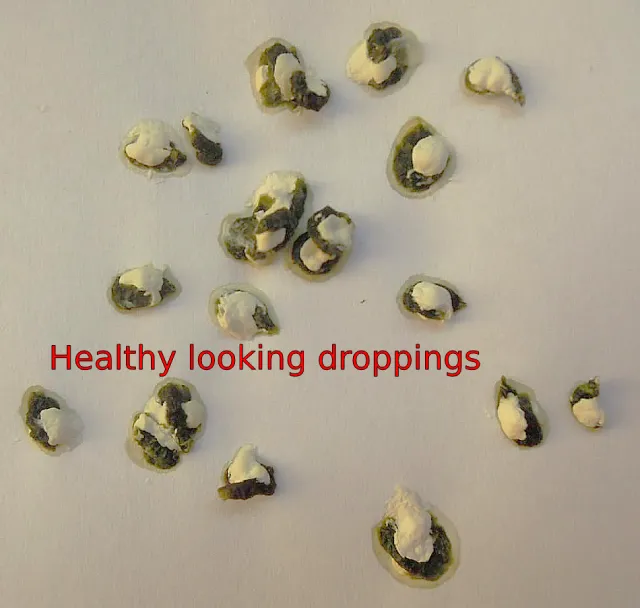
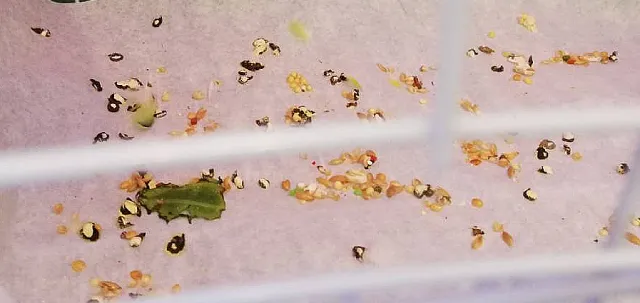
Each has its own unique appearance and texture, and together, they form the full picture of your budgie’s health.
The feces part should be tubular and solid, exhibiting a shade of green or brown depending on your budgie’s diet.
The urine, on the other hand, is typically clear and liquid, surrounding the feces.
Lastly, the urates, or the white part of the droppings, is usually pasty and should not contain any color.
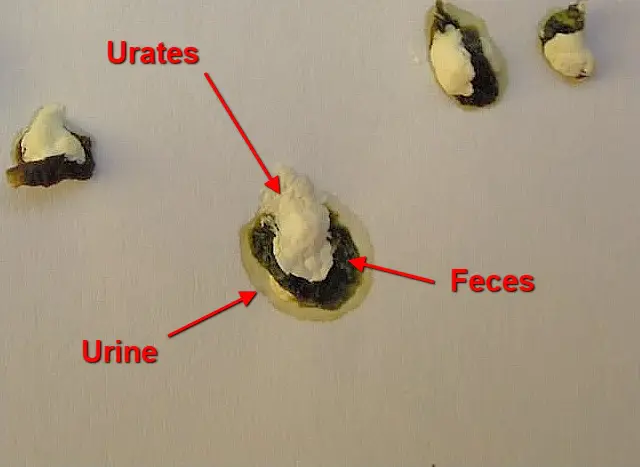
Feces
The feces component of your budgie’s droppings comes from the digestive tract, carrying waste materials that your feathered friend’s body doesn’t need.
It’s generally tubular in shape and firm but not hard.
The color of the feces can vary widely depending on your budgie’s diet.
For instance, if your budgie’s diet is predominantly seed-based, the feces might be lighter in color, often appearing as a greenish hue.
If the diet is rich in fruits and vegetables, however, the feces could display a darker green, or even black, color.
Urine
The urine is the watery part of your budgie’s droppings.
It’s essentially the bird’s way of excreting excess water, and thus, should appear clear and colorless.
A healthy budgie’s droppings should have a moderate amount of urine, enough to moisten the feces but not so much as to make the droppings runny or overly wet.
An increase in the quantity of urine could be a sign of increased water intake, potentially indicating a health issue.
Urates
Lastly, the urates.
These are the white or cream-colored pasty substance you often see in your budgie’s droppings.
They come from the urinary tract and are essentially concentrated uric acid, a waste product that your budgie’s body doesn’t need.
The urates should not contain any color.
If they do, it could indicate a potential health problem.
For instance, yellow or green urates might be a sign of liver disease, while red or brown urates could hint at possible blood in the urine.
White Budgie Poop
Observing white budgie poop might leave you feeling a tad concerned.
And rightly so.
A completely white dropping, lacking the typical green or brown feces part, is not a regular sight.
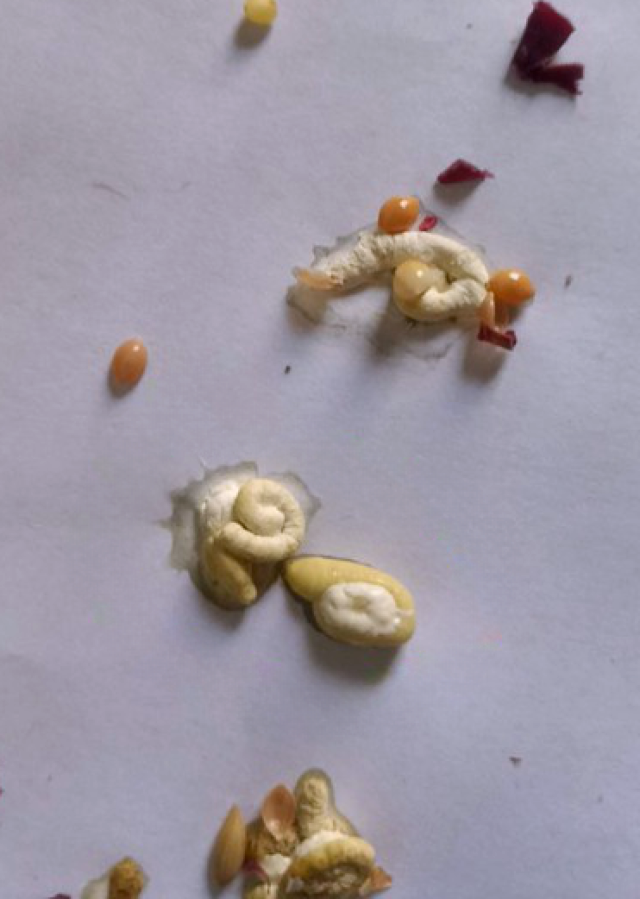
It could potentially indicate that your budgie isn’t eating enough, leading to a lack of feces in their droppings.
Moreover, a large quantity of white material, particularly if pasty or chalky, may point to an excess of urates.
Such a situation can be an early warning sign of potential kidney disease or other health issues.
Therefore, it’s essential to consult with a vet if your budgie produces entirely white droppings.
Yellow Budgie Poop
Coming across yellow budgie poop can certainly raise eyebrows.
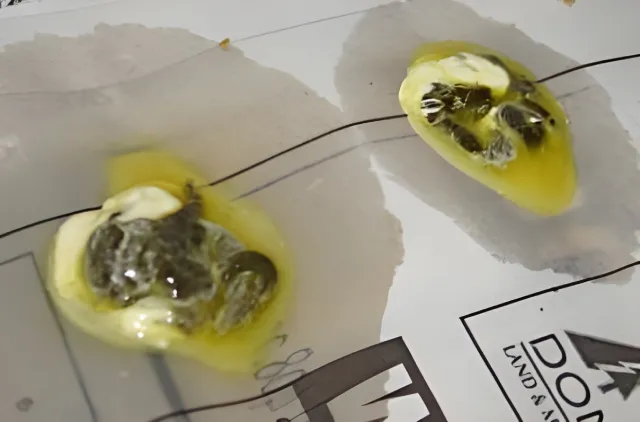
Yellow color in the feces part of the droppings is not normal and might indicate a dietary issue or health concern.
If the urates part of the droppings appears yellow, it could be a sign of a potential liver problem.
This color change happens because the liver might be failing to properly process bilirubin, a waste product that usually gets excreted with the feces.
If you spot yellow in your budgie’s droppings, a vet visit is in order.
Green Budgie Poop
Finding green budgie poop in the cage is generally a common sight for budgie owners, especially if your pet has a diet rich in greens or vegetables.
It’s typically the feces part of the droppings that manifests this color.
However, if the green color seems overly dark or the droppings are excessively soft or loose, it might be cause for concern.
Such symptoms could hint at dietary problems or potential gastrointestinal issues, in which case, seeking veterinary advice would be a wise decision.
Green And White Budgie Poop
Now, let’s discuss green and white budgie poop.
This color combination is typically what you should expect from a healthy budgie.
The green represents the feces, while the white symbolizes the urates.
That being said, any drastic changes in the shade of green, the consistency of the white urates, or the overall texture of the droppings should prompt a closer examination.
Light Green Budgie Poop
When it comes to light green budgie poop, it’s usually not a cause for concern.
In many instances, this color is a normal result of a budgie’s diet, particularly if it includes a good amount of seeds.
For instance, extremely light or whitish droppings might suggest that the budgie isn’t eating enough or has a blockage in its digestive tract.
On the other hand, lighter urates could mean the bird is consuming more water than usual, which could signal potential health concerns like kidney disease.
Dark Green Or Black Budgie Poop
Encountering dark green or black budgie poop might feel alarming, but it doesn’t necessarily spell trouble.
Budgies that consume a diet rich in fruits, vegetables, or pellets often produce dark green or even black feces.
However, sudden changes to a darker shade, especially if the feces become tarry or sticky, could indicate bleeding in the upper gastrointestinal tract.
In such instances, it’s crucial to get in touch with a vet without delay.
Brown Budgie Poop
Observing brown budgie poop is generally nothing to fret about.
Brown feces often occur when the bird’s diet includes various types of fruits or pellets.
However, the key is consistency.
If the color of the droppings changes suddenly or there’s a shift in the texture or frequency, it could be indicative of a health issue.
Keep an eye out for any accompanying symptoms such as changes in appetite, behavior, or activity levels.
Watery Or Runny Droppings
Watery or runny droppings are a common sign of diarrhea in budgies.
Diarrhea can occur due to a variety of reasons, such as a change in diet, stress, or an underlying health condition like a bacterial or parasitic infection.
While a single occurrence of watery droppings might not be alarming, persistent runny feces warrant a vet’s attention.
It’s essential to act promptly as diarrhea can lead to dehydration and potentially severe health complications if left untreated.
Red, Orange, Purple Budgie Poop
Discovering red or orange budgie poop can be concerning, but it doesn’t always indicate a serious health issue.
In some cases, the color change can be attributed to the food they consume.
Certain fruits, like oranges, red berries, carrots, blueberries, and baked sweet potatoes can result in vibrant-colored droppings.
This is normal and not a cause for alarm.
However, if the red or orange color persists beyond dietary influences or is accompanied by other symptoms such as changes in behavior, appetite, or consistency of droppings, it’s advisable to consult a veterinarian.
Excessive Urine Or Urates
Finding excessive urine or urates in your budgie’s droppings is another sign that shouldn’t be ignored.
An increased amount of urine could be due to increased water intake, potentially signaling kidney disease or diabetes.
Excessive urates, on the other hand, may be indicative of kidney disease or other health concerns.
In both instances, seeking professional veterinary advice is crucial to ensure your budgie receives the care it needs.
Remember, early detection often leads to better outcomes.
Mucus Or Blood
Finding mucus or blood in your budgie’s droppings is a serious concern.
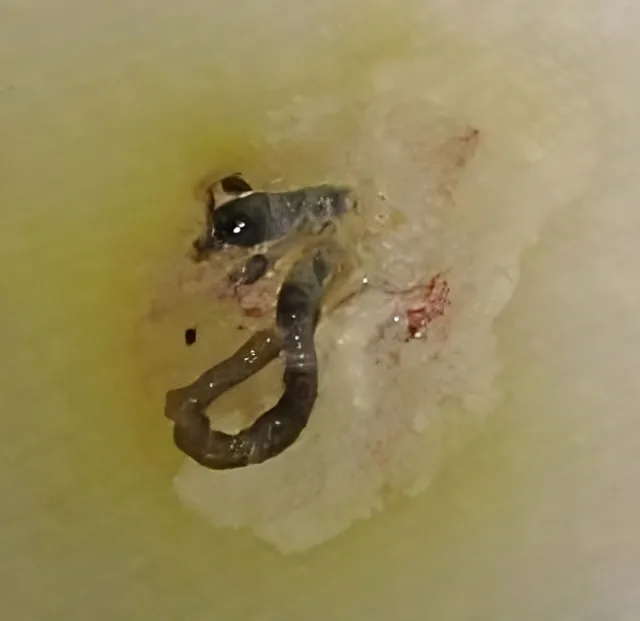
Mucus could indicate a gastrointestinal infection or parasite, while blood may signify internal bleeding.
It’s critical to remember that blood in the droppings could appear dark and tarry if it’s from the upper gastrointestinal tract or bright red if it’s from the lower tract.
Regardless of the presence of mucus or blood, immediate veterinary attention is necessary to diagnose and treat the underlying condition.
Dry And Crumbly
A change in droppings to a dry and crumbly texture could signify a problem.
Dehydration, poor nutrition, or certain diseases can result in dry feces.
Keeping your budgie well-hydrated and providing a balanced diet can prevent this condition.
However, if your budgie’s droppings continue to be dry and crumbly, it’s best to consult with a vet.
They can help identify if an underlying health concern is causing the problem.
Sticky Or Pasty
Sticky or pasty droppings can be a symptom of an unhealthy diet or a possible health concern.
A diet high in moisture, such as one abundant in fruits and vegetables, can sometimes cause stickier feces.
However, sticky droppings could also indicate a potential digestive issue.
Stringy Or Elongated
Coming across stringy or elongated droppings might seem odd, but it isn’t always cause for alarm.
Budgies, especially those on a seed-heavy diet, often produce these kinds of droppings.
Extremely Large Droppings
Discovering extremely large droppings in your budgie’s cage might make you wonder.
In some cases, these large droppings could simply be a result of your bird eating more than usual.
It’s a common occurrence for droppings to increase in size after a big meal.
However, a constant pattern of large droppings could suggest problems such as overeating or digestive issues.
Moreover, if you own a female budgie, you might notice that her droppings become significantly larger when she is carrying an egg.
This is a normal occurrence as the egg can press against the intestines, causing larger-than-normal droppings.
It’s essential to ensure that your female budgie gets enough calcium during this time to help with egg formation and to avoid complications.
Undigested Food In Droppings
Finding undigested food like seeds or pieces of vegetables in your bird’s droppings is a sign of severe impairment in digestion.
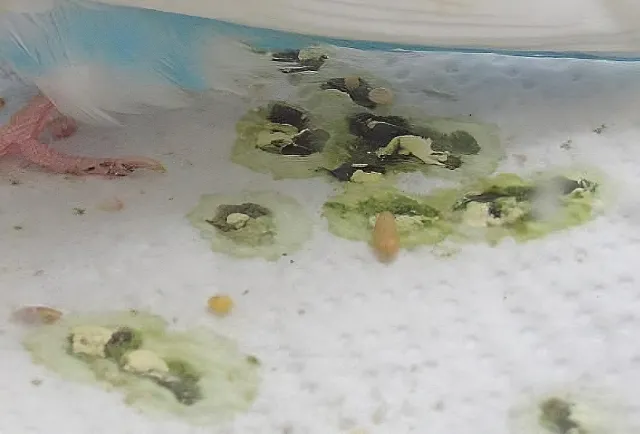
metal toxicity (Image credits: mickaboo.org, upscaled)
This condition should not be ignored, as it can lead to malnutrition or other nutritional deficiencies if left untreated.
There are various potential causes for such digestive disorders in birds.
One common culprit is avian gastric yeast, also known as Megabacteria, which affects a significant number of budgies.
In other bird species, bacterial infections can result in undigested grains being present in the droppings.
Occasionally, pet birds may pass parasites like roundworms in their droppings.
This can occur during or after a deworming treatment.
However, if you observe the presence of a roundworm in your bird’s feces on the floor without having administered deworming medication, it is crucial to urgently take your bird to a vet for treatment initiation.
Starting therapy as soon as possible is vital because roundworms, due to their body length, can become entangled in a bird’s intestine, leading to potentially fatal intestinal obstruction.
Budgie Poop Behavior
Understanding budgie poop behavior can provide crucial insights into your bird’s health.
You might be curious about when budgies poop, how often, and what can change these patterns.
When Do Budgies Poop?
Budgies, like most birds, poop at any time throughout the day.
They don’t have a specific poop schedule like some animals do.
However, they typically have a bowel movement shortly after eating.
You might also find an accumulation of droppings in the morning as budgies, being diurnal creatures, tend to eat more during the day and excrete waste when they wake up.
How Often Do Budgies Poop?
On average, a budgie might poop every 10-20 minutes.
But how often budgies poop can vary depending on factors like diet, hydration, and activity level.
Straining Or Discomfort During Droppings
Straining or showing discomfort during droppings is not normal for budgies.
This could indicate constipation, an obstruction, or other health issues.
Straining might look like your budgie is pushing harder than usual to excrete, while discomfort can manifest in restlessness, loss of appetite, or unusual behavior.
Eating Own Droppings (Coprophagy)
Though it may seem strange to us, eating their own droppings, or coprophagy, is common in many bird species, budgies included.
They do this to extract any remaining nutrients from the droppings.
However, frequent coprophagy could indicate a nutrient deficiency, and it would be wise to review your budgie’s diet or consult with a vet if this behavior persists.
Why Is Your Budgie Pooping On You?
If you find yourself wondering, “Why is your budgie pooping on you?” the answer is straightforward.
Budgies, as previously mentioned, poop quite frequently and without a specific schedule.
When perched on you, they’re just as likely to poop as when they’re on their perch.
It’s not a sign of disrespect or anger; it’s just a part of budgie life!
Do Budgies Poop While Flying?
Yes, budgies do poop while flying.
Since budgies don’t have the ability to control their bowel movements like mammals do, they can’t hold it in while they’re in the air.
They simply go whenever and wherever the need arises.
So, if you see a little surprise on the floor after your budgie’s flight, don’t be shocked.
It’s all part of owning these delightful little birds!
What Are The Diseases That Can Be Detected From The Poop Of Budgies?
Budgie’s poop can tell a lot about their health.
Changes in color, texture, or frequency of droppings can indicate various diseases.
The following are some of the main health issues that can be diagnosed by examining a budgie’s poop:
Bacterial Or Parasitic Infections
Bacterial or parasitic infections can cause changes in the color, consistency, and frequency of your budgie’s droppings.
Such infections can make the droppings watery, discolored, or unusually smelly.
In some cases, visible parasites may be present in the droppings.
Liver Or Digestive Disorders
Liver or digestive disorders in budgies can result in greenish or yellowish droppings.
The feces may also become runny or irregular in shape, which is a sign that food isn’t being processed properly in the digestive tract.
Nutritional Deficiencies
Budgies suffering from nutritional deficiencies may produce droppings that are lighter in color, often due to a lack of certain nutrients in their diet.
The feces may also be smaller or larger than normal, or have a strange texture.
Gastrointestinal Issues
Changes in droppings can also indicate gastrointestinal issues.
Budgies suffering from these problems may produce poop that is watery, irregular in shape, or contains undigested food.
They might also poop less frequently or appear to be straining when they do poop.
Respiratory Infections
While not directly detectable through poop, respiratory infections can cause changes in poop frequency and consistency as they can affect the bird’s overall health and eating habits.
Kidney Disease
Kidney disease can be detected through changes in the urine component of your budgie’s droppings.
The urine may become excessive, or the urates (the typically white or cream part of the droppings) may become yellow or green.
Intestinal Blockage
Intestinal blockage is a serious condition that may cause a budgie to strain during droppings, produce unusually small or large droppings, or stop producing droppings altogether.
In some cases, the droppings may contain blood or mucus.
Are There Any Diseases That Can Be Transmitted To Humans From The Poop Of Budgies?
Yes, there are a few diseases that can potentially be transmitted to humans from the poop of budgies.
One of the most common diseases is Psittacosis also known as parrot fever, which is caused by the bacterium Chlamydia psittaci.
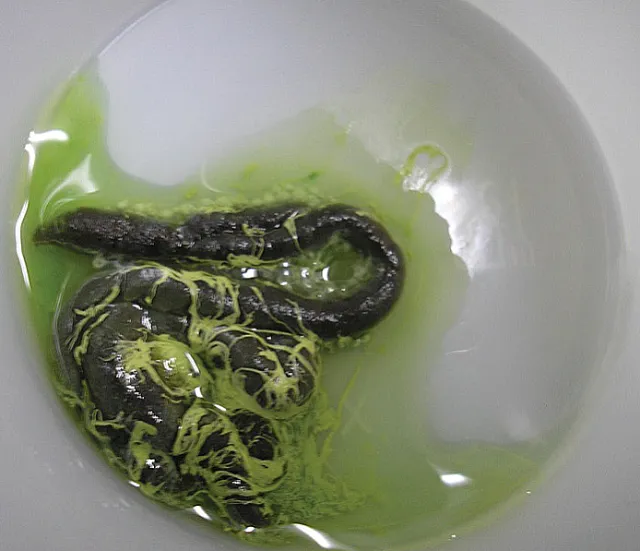
It can be transmitted to humans through inhalation of dust from dried feces of infected birds.
Symptoms in humans include fever, chills, headache, muscle aches, and a dry cough.
Another possible disease is Campylobacteriosis, caused by the bacteria Campylobacter, which can be transmitted through contact with feces of a sick bird.
In humans, it generally causes gastrointestinal symptoms such as diarrhea, stomach cramps, and fever.
However, it’s important to note that these transmissions are rare, and maintaining good hygiene and regular veterinary check-ups for your budgie can significantly minimize these risks.
Faqs
Do Budgies Poop Smell?
Under normal circumstances, budgie poop should not have a strong smell.
If you notice a strong, foul odor coming from your budgie’s droppings, it might be an indication of a health issue, such as a bacterial infection or a digestive problem, and you should consult a vet.
How Do I Prevent The Budgie From Pooping All Over The Place?
To prevent your budgie from pooping all over the place, try to train your budgie to poop in a specific area.
This might take time and patience.
Regularly cleaning their cage and surrounding areas can also help maintain cleanliness.
Using bird cage liners or trays can make the cleaning process easier.
Is Budgie Poop Dangerous To Humans?
In general, budgie poop is not dangerous to humans.
However, there are a few diseases like Psittacosis and Campylobacteriosis that can be transmitted from budgies to humans, though these are quite rare.
Maintaining good hygiene practices, like washing hands before and after handling your budgie or cleaning its cage, can help prevent potential transmission of diseases.
Is Budgie Poop Dangerous To Cats?
Under normal circumstances, budgie poop is not directly harmful to cats.
However, if the budgie is carrying a disease or parasites, the poop might carry those as well, which could potentially be harmful if ingested by the cat.
This is relatively rare, but it’s always a good idea to prevent your cat from playing with or ingesting your budgie’s poop to avoid any possible health risks.
Is Budgie Poop Dangerous To Dogs?
Budgie poop is not typically harmful to dogs.
However, if the poop contains disease-causing organisms or parasites, there could be a potential risk if ingested.
Therefore, it’s best to keep your dog away from the budgie’s droppings as a general precaution.
Is Budgie Poop Dangerous To Other Birds?
Yes, it can be.
Budgies can carry diseases or parasites that could be harmful to other birds.
Diseases can be passed through droppings and can spread rapidly in bird populations.
Therefore, if you have multiple birds, it’s important to monitor their health closely and ensure their environment is clean to prevent possible transmission of diseases.
Is It Worth Potty Training Your Budgie?
Yes, it’s absolutely worth potty training your budgie if you have the patience for it.
It can help maintain cleanliness in your home and reduce the effort needed for cleaning.
Keep in mind, though, that it requires a consistent routine and positive reinforcement.
It’s also important to remember that even a well-trained budgie may have accidents, as their control over their bowel movements is limited.
Do Budgies Pee?
No, budgies don’t pee like mammals.
Instead, they excrete waste in the form of urates, which are the white part of their droppings.
Urates are the byproduct of protein metabolism, similar to how mammals excrete urea in urine.
So, in essence, when a budgie poops, it’s also ‘peeing’ at the same time.
How Can You Identify Healthy Budgie Droppings?
Healthy budgie droppings typically consist of a small, round, and firm feces part that is dark green to brown in color, and a white to off-white portion, which is the urates.
The droppings should not be overly watery or dry, and there should be no sign of blood or unusual colors like bright yellow or red.
Regularly inspecting your budgie’s droppings is crucial for monitoring their health.
What Could Cause A Change In Budgie Dropping Colors?
Changes in budgie dropping colors can be caused by various factors.
If the droppings turn white or light, it could indicate a diet high in seeds or a liver disorder.
Green poop may result from a high vegetable diet or bacterial infection.
Red or orange droppings could be due to bleeding or a diet rich in red or orange foods.
Always consult a vet when in doubt.
How To Treat Diarrhea In Budgies?
Treating diarrhea in budgies depends on the cause.
For mild cases, ensuring that your budgie is hydrated and fed a balanced diet can be helpful.
If the diarrhea persists or if the bird shows other symptoms like lethargy or weight loss, you should consult a veterinarian immediately.
The vet may prescribe antibiotics, antifungals, or other treatments based on the underlying cause.
Can Budgie Droppings Indicate Stress?
Yes, budgie droppings can indicate stress. Stress in budgies may cause changes in poop consistency, such as watery or runny droppings.
The droppings may also become more frequent.
Why Should You Regularly Clean Your Budgie’s Cage?
Regularly cleaning your budgie’s cage is important to maintain a healthy environment and prevent diseases.
Budgie droppings can accumulate bacteria and fungi over time, which can cause health issues if left unchecked.
Regular cleaning also allows you to monitor your budgie’s droppings for any changes, which can be crucial for early disease detection.
Sources
- https://www.birds-online.de/wp/en/birds-online-english/health-and-diseases/general-health-topics/signs-of-illness/what-droppings-tell-you/ (Web Archive Link)
- https://web.archive.org/web/20221206075334/https://mickaboo.org/sites/default/files/files/4q2010_newsletter_Poopology.pdf
- https://mickaboo.org/sites/default/files/files/4q2010_newsletter_Poopology.pdf
- https://web.archive.org/web/20230602201947/https://nilesanimalhospital.com/files/2012/05/The-Dropping-_-An-Indicator-of-Health.pdf
- https://nilesanimalhospital.com/files/2012/05/The-Dropping-_-An-Indicator-of-Health.pdf
- https://www.auspigeonco.com.au/dropping-interpretation.html (Web Archive Link)
